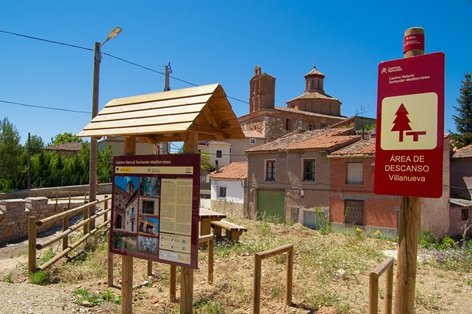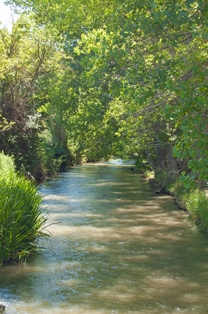- Home
- Rural Development
- Nature Trails
- Nature Trails
- Northwest Sector
- Santander-Mediterráneo
Santander Mediterráneo Nature Trail. Daroca section
Description

Accompanying the Jiloca River, just like the railway did, and protected by the coolness of the forest on its bank.
The vineyards kept watchful eye over the path of the old railway as did the trilobite fossils of Murero, whose small cross monoliths delimited its frontiers with Manchones. Daroca was already standing powerful, monumental and open armed, welcoming railway travellers through the Lower Gate who would end up on the calm riverside of Villanueva de Jiloca Where in days gone by you could hear the clattering of the train, now you can hear groups of hikers and cyclists who will doubtless have stories to tell about this valley.

This section, of little more than 15 kilometres, begins in the municipality of Murero, then enters a tunnel of the same name which, being 535 metres long and perfectly refurbished and lit, makes it a delight for cycling tourists
Once passed this old railway line feature, travellers can experience firsthand two treasures of the municipality: its vineyards and its famous wine. Amongst all of the particularities which make this wine stand out, it’s worth highlighting its centennial strains of the Grenache grape, cultivated on chalky lands which bring unbeatable organoleptic qualities.

Continuing by the old railway line trail, with the Jiloca River as a faithful companion on the left, hikers can see the San Mamés shrine, a place which is well loved by "Mureños" (people form Mureño) who, every 17 of August, congregate in this place together with tourists and residents of the nearby towns in order to celebrate a pilgrimage full of tradition and symbolism.
The old railway trail continues comfortably, arriving at the old Murero station called Manchones, where the old travellers reception building and the toilets still remain standing, although they embody the relentless passing of time. Next to them, a new rest area lets cyclists and walkers regain their strength and investigate the interpretive panels on display, which show the other characteristic element of Murero: the paleontologic settlement of the Rambla de Valdemiedes. There, fossils of some 80 different species of trilobites have been found.

Before crossing the road which leads to Murero, travellers can visit its rural centre where the parish church of Santa Maria La Mayor is a highlight. The journey continues south-east with the old railway trail and teases the Jiloca River, gently approaching and moving away. At the crossing of the road leading towards Manchones, where the bell tower of the San Pablo parish church is dominating the landscape, different buildings can be seen, reminding travellers of the railway line on this route. Then, another rest area can be reached.

Some kilometres later, travellers reach the old Daroca station, which had a storehouse, a crane, a water deposit and other elements which endowed this complex railway line with a certain importance. In addition to these aspects which held a former importance, today there is a rest area, an interpretive panel which will delight travellers.
Little more than a kilometre onwards you find the town of Daroca which, in its enormous architectural heritage, is an essential stop on the itinerary. Its age-old walls evidence its defensive nature and the privileged position of this settlement. Both its Lower and Upper Gates used to welcome travellers who arrived from different parts of the peninsula; Daroca was considered a stopping point and a place of transit.

Continuing the trail we slowly move away from the monumental town of Daroca, moving between cereal crops and river banks which offer an attractive colourful mosaic. Finally, we reach the last settlement of this section, Villanueva de Jiloca. A new resting point welcomes the traveller, presenting him with some beautiful views of the town while he regains his strength, The church of San Gil Abad stands tall and has two shrines in the vicinity of the rural centre in honour of Saint Bartholomew and Nuestra Señora del Rosario, constructed in the 15th and 16th Centuries respectively.
Here, cyclists face the last part of this section which ends at the same time as the municipality of Villanueva de Jiloca, next to the river, near a waterfall and a small meadow with shade. A unique place where one can no doubt review their experience in the section of Campo de Daroca, of the Santander-Mediterranean Sea Nature Trail
Sites of interest
Map
Puntos de Interés
Cultura
- Ermita de San Roque
- Ermita de San Mamés
- Ermita de la Virgen del Rosario
- Torre de Nuestra Señora del Pilar
- Ermita de San Bartolomé
- Ermita de la Virgen del Pilar
- Murallas de Daroca
- Ermita del Carmen
- Ermita de la Virgen del Pilar
- Ermita de San Roque
- Ermita del Carmen
- Ermita de San Mamés
- Torre de Nuestra Señora del Pilar
- Murallas de Daroca
- Ermita de San Bartolomé
- Ermita del Carmen
- Ermita de San Bartolomé
- Ermita de San Mamés
- Ermita de San Roque
- Ermita de la Virgen del Pilar
- Murallas de Daroca
- Ermita de la Virgen del Rosario
- Ermita de la Virgen del Rosario
- Torre de Nuestra Señora del Pilar
Hidrografía
Profile

Featured
Further information
Daroca
Town which gives name to the region Campo de Daroca Of Celtiberian origin (Darek), with importance in Roman times (Agiria) and in Muslim ones (Calat-Darawaca), it was a place of reference after the Christian Reconquest as well ass throughout the Middle Ages. A boarder and stopping point, its two gates, the Lower Gate and the Upper Gate, have welcomed travellers and visitors for centuries. In addition to its great architectural heritage, where over 4 kilometres of walls with towers such as that of San Cristobal and Jaque stand out, the monumental Fuente de los Veinte Caños and the basilica of Santa Maria de los Sagrados Corporales, made it obtain in 1931 the status of historic
The natural heritage is centred around the Jiloca floodplain which, due to its fertile lands, produces a rich and varied horticulture which is apparent in its gastronomy too. There are also various longer distance routes which pass through the city and a good handful of local routes which explore the interesting and different nooks and crannies which Daroca hosts.
Corpus Christi is its most important festival which was established in 1264 by Pope Urban IV, commemorating the miracle of the Corporals and which is celebrated, depending on the year, between the end of May and the beginning of June. Easter and Saint Thomas Day on the 7th of March are another cause for celebration. But undoubtedly, one of the most important important events of the year takes place at the end of July, when Daroca decorates its streets to celebrate its medieval fair. This is an intriguing event which attracts many locals and visitors.










